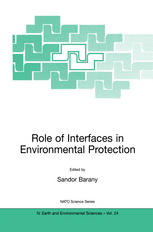

Most ebook files are in PDF format, so you can easily read them using various software such as Foxit Reader or directly on the Google Chrome browser.
Some ebook files are released by publishers in other formats such as .awz, .mobi, .epub, .fb2, etc. You may need to install specific software to read these formats on mobile/PC, such as Calibre.
Please read the tutorial at this link: https://ebookbell.com/faq
We offer FREE conversion to the popular formats you request; however, this may take some time. Therefore, right after payment, please email us, and we will try to provide the service as quickly as possible.
For some exceptional file formats or broken links (if any), please refrain from opening any disputes. Instead, email us first, and we will try to assist within a maximum of 6 hours.
EbookBell Team

4.1
70 reviewsThe NATO Advanced Research Workshop "Role of Interfaces in Environmental Protection" has been held on May 27-30, 2002 in Miskolc, Hungary, under leadership of co-directors Prof Sandor Barany from the University ofMiskolc, Hungary, and Prof Nataliya Klymenko, National Academy of Sciences of Ukraine. The objective of the ARW was to highlight colloidal and biocolloidal aspects of environmental pollution and technologies to monitor, remediate, abate and prevent pollution. It is known that the solution of majority of environmental problems is closely connected with phenomena at the interfaces. The behaviour, transport of dispersed particles in the environment, the main phase separation methods in water treatment, purification of liquids, aerosols removal, many soil remediation processes as well as the methods of protection of human organisms from hazardous matters, are based on concepts of colloid chemistry, i.e. properties of interfaces and their behaviour in different media. Examples of these methods are: filtration, ultrafiltration, flotation, coagulation, hetero-coagulation and flocculation, adsorption, adhesion of micro-organisms to surfaces, membrane separation methods, etc. A very important and special aspect of the topic is the human protection using colloid-chemical approaches, i.e. the adsorption, aggregation and adagulation properties of differe~t materials. Examples are: adsorption of hazardous organic materials, drugs, heavy· metals and radionuclides on activated carbon, silica, cellulose derivatives, etc.